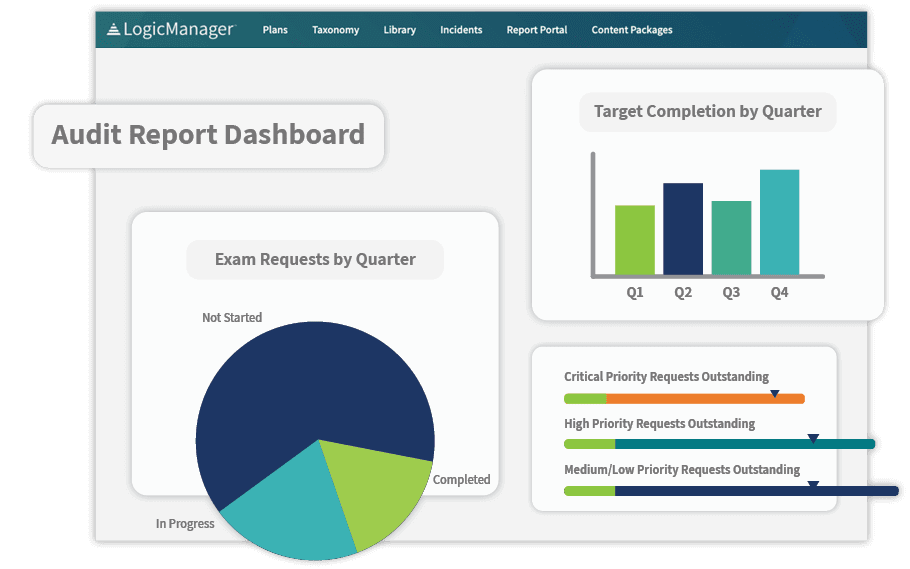Audit Control Testing
LogicManager's risk-based audit management software helps prioritize business goals, operational objectives, and key processes to add efficiency to audit planning and execution.
This application can be achieved through:
Why a Risk-Based Approach to Audit Control Testing is important:
LogicManager’s Control Testing Solution for Audit Management
- Leverage fully configurable testing tools to automate the collection of results from end users and establish a set testing cycle, eliminating the need to track people down and allowing you to easily spot bottlenecks.
- Customize the LogicManager home screen so that it only displays the most relevant information based on your end users (e.g. their list of controls to review, a testing dashboard, or documentation editing integration points) to keep information centralized and eliminate distractions.
- Our built-in Controls & Control Suggestions provide intelligent insights into the controls you already have in place and which ones apply to a given risk across business units, allowing you to reduce the quantity of controls that must be tested and ultimately shrink your compliance burden.
- LogicManager’s Automated Assurance connects any failed controls with the risks they’re impacting and instantly updates those risks’ assurance scores, empowering you with the real-time risk awareness needed to proactively improve controls.
- Use our Reporting & Dashboards tools to visually communicate support for your conclusions, control deficiencies, historical results of testing, testing calendars, and more to continually improve your program.
Related Integrations:

COMPLIMENTARY DOWNLOAD:
Risk Focuses for Auditors Infographic
Risk Focuses for Auditors Infographic
Internal Auditors should include risk-related responsibilities into their scope of work and our infographic show you how.
Achieve Control Testing with LogicManager
Maintain a centralized repository
A strong testing program enables you to provide evidence that your controls are working effectively to any stakeholders, be that your board, external auditors, or examiners. Keeping a centralized repository of all of the testing you’re performing allows you to easily produce evidence on the overall strength of your program. Should any stakeholder wish to drill into those results further, you’ll be able to provide them with those details.
Identify areas for improvement
As an auditor, it’s your job to determine where there are opportunities to improve your programs so that your organization can defend itself against undue risk. By performing ongoing reviews of your controls, you can easily identify areas where you’re less protected than you may have realized and ultimately redesign controls for reinforcement.

What is Control Testing in Auditing?
Control testing is one of the most fundamental processes within your audit management program. It’s often referred to as an “audit test of controls.” These auditing procedures evaluate whether a company’s internal controls are sufficient enough to effectively prevent risks related to material misstatements from manifesting. Control testing is used by auditors to reduce the workload or number of sampling needed during the substantive test or detail test.
Internal control testing is typically completed during the audit planning phase, but in practice, might be done at the execution stages. As a best practice in auditing, there is a three-year rotation for control testing. However, if the auditor plans to rely on a test of controls related to a significant risk, effectiveness must be tested on an annual basis.
Risks
Missing risk exposure leaves any organization vulnerable to threats that they might otherwise be able to protect themselves from completely. No matter how important it is to eliminate blind spots, testing controls can be a cumbersome and lengthy process that exhausts FTEs and other critical resources.
Oftentimes, audit requests have a tight turnaround time. Without automated tools, your testing procedures may require such extensive administrative efforts that the deliverables are not completed in time to make the deadline.
Perhaps your testing is automated but unorganized. An unorganized testing process can result in duplicative efforts or missed information. It can also lead to tests not being performed correctly and leaving you blind to key vulnerabilities.
Request a DemoLearn How LogicManager’s Audit Control Testing Software Can Transform Your Audit Management Program
Speak with one of our risk specialists today and discover how you can empower your organization to uphold their reputation, anticipate what’s ahead, and improve business performance through strong governance.


